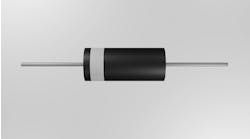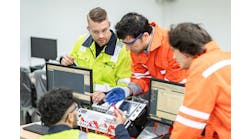There are a host of options in the marketplace when it comes to automation. It can be an emotionally charged argument over which brand rules the world, especially when the discussion centers around the PLC and PAC. Fortunately, there are a lot of good products out there, but one product we tend to overlook is the smart relay, mini-PLC, programmable relay or similar.
The original purpose of these smart relays was to fill the gap between individual components, such as timers, counters, contactors or relays, and a PLC. Dozens of automation companies offer smart relays. You can find products with about 10 inputs and four to six outputs with various input and output voltage specifications. There are many similarities between manufacturers, so what separates the brands, and how do you know what you’re going to get when you open the package?
The best place to start is to determine what you’re trying to achieve. If you simply want to add a time delay to a photo eye and turn on an output, then a smart relay will serve that need. If you want something more, then there’s certainly a lot out there to consider. The gap between mini-PLCs and my favorite small-system PLC was surprisingly close. It made me reconsider why I’m spending so much for the small-system PLC when I could get the same results with something less expensive—the mini-PLC or smart relay.
For a lot of automation programmers, the choice of mini- versus small PLC system has always been about the familiarity of your favorite programming software or technique. I learned to program on an Allen-Bradley PLC-2 platform and its later generation PLC-3, PLC-5, SLC 500 and CompactLogix/ControlLogix platforms, so that has a feel of home to me. Having said that, I also cut my teeth on the early Omron PLCs, such as the C20, C20K, C40K and C200H, and I had several years of exposure to Modicon, Texas Instruments and Siemens processors. Those experiences have taught me that, if you get past the brand name and look at the functions inside, there is much to be said, pro and con, for any brand of controller, but they are all capable of the same core functions. It’s really about what you are willing to invest as far as learning the flavor of each product.
From humble beginnings, mini-PLCs have really taken on a whole lot more. Early smart relays were programmed using the embedded monochrome screen and the accompanying navigation keypad, but this migrated to using some form of a serial connection to program with a laptop or computer. These days most of you can now communicate in your favorite fieldbus connection. This opens a whole world up because now your mini-PLC has the ability to connect and interact with its bigger brothers and sisters. While the mini-PLC might have been used for very small, stand-alone applications, the ability to interact with other PLCs means that it is possible to make them an integral part of a larger control system without having to deploy the bigger PLC in a field location. If you have an application that risks damage due to use, then a cheap but powerful PLC in that location can certainly reduce the risk and downtime associated if it can be easily swapped out.
Looking beyond the connectivity, mini-PLCs now have the capability of add-on modules. Everything from standard digital and analog I/O to communications scanners, memory backup, RTD modules, trim pots, thermocouple inputs are all part of the collection of expansion available for these new-age mini-PLCs. With an arsenal like this, it becomes a more serious decision about whether to use the traditional micro-PLCs when you do as much and more with the newer families of smarter smart relays.
An important consideration when specifying this newer technology is to delve into the programming of the smart relay. Some use function block, others ladder logic in the traditional North American style while others use what I would call the European ladder logic. I refer to the ladder logic that resembles a Siemens processor where the timer, for example, has inputs and outputs that are programmed more like a function block. There are even some older smart relays that use gate logic for programming. It’s easy to recognize that most maintenance electricians, especially the newer ones, aren’t going to be able to follow gate logic when troubleshooting a problem.
Another thing that has come a long way is the programming software itself. Many companies used to charge a fee for the software. It was a bitter pill to swallow when you would pay $200-$300 for a smart relay and then have to put out the same, in some cases, for the software to program it. Hardware companies are starting to figure out that they don’t make their money in software and, if given the choice, many users would pick a competitor’s brand of hardware, with comparable features, if they didn’t have to fork out money for the software.
ALSO READ: The father of the PLC shares his thoughts on creating 'big solutions'
Recently, I was asked to look into how we would bring about data collection in our main production facilities. It has long been a goal of mine to connect all of the assembly and process lines to some sort of central system. While my motivation might have been driven by not wanting to drag a programming cart and a laptop out into the bowels of the beast every time I needed to monitor some process, it has been my dream to bring about a data collection system to provide real-time data to our managers and supervisors so that they could use more than a gut feeling to drive the decision-making process. The challenge that we faced is how to get 40-year-old, relay-controlled packaging equipment to spit out data to a collective. The solution has presented itself in the use of smart relays. It was the perfect solution to my need. I only need to collect the pulse off two or three points on each production line, and, from that data, a software solution will produce overall-equipment-efficiency (OEE) metrics that we can use to make smarter decisions. The ability to connect that smart relay to my plant Ethernet network gave me a way to accomplish my needs. The great part is I get to stay in my feel-good zone by using a smart relay from my favorite automation supplier using a comfortable, familiar programming environment.
Finally, there is another aspect of mini-PLCs that I came upon during my journey of discovery. I have long been aware of safety controllers and I have used them in a number of control designs over the years. Having a specific control platform to take care of all the safety-related items, such as emergency stops, light curtains, guard switches and safety mats, can’t be underestimated. These safety controllers make specific use of the features of these devices and combine them into the programming structure with seamless integration. I was happy to learn that my favorite mini-PLC has a cousin that is a safety controller. It uses the same footprint, and even the same wiring terminations, as my mini-PLC. Most importantly, it also uses the same programming software. While the safety controller looks different due to the color of the casing, it can also use the same expansion modules that my mini-PLC uses for additional functionality.
Smart relays have come a long way in the past 15-20 years, and some consideration during your next brain-storming session may bring some surprising results.
Rick Rice is a controls engineer at Crest Foods, a dry-foods manufacturing and packaging company in Ashton, Illinois. With nearly 30 years’ experience in the field of automation, Rice has designed and programmed everything from automotive assembly, robots, palletizing and depalletizing equipment, conveyors and forming machines for the plastics industry but most of his career has focused on OEM in the packaging machinery industry with a focus on R&D for custom applications. Contact him at [email protected].






